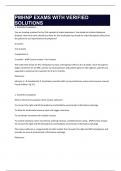PMHNP EXAMS WITH VERIFIED
SOLUTIONS
1. Scientific Foundation
You are treating a patient for his first episode of major depression. You decide to initiate citalopram
(Celexa). How much time should you allow for the medication to provide its initial therapeutic effect and
the patient to see improvement of symptoms?
8 months
4 to 6 weeks
2 weeksterm-2
2 months - ✔✔Correct answer: 4 to 6 weeks
The initial time frame for this medication to have a therapeutic effect is 4 to 6 weeks. Once the patient
begins treatment on an SSRI, and the nurse practitioner and patient agree on the regimen, patients are
expected to continue this treatment for 6 to 12 months.
Reference:
Johnson, K., & Vanderhoef, D. Psychiatric-mental health nurse practitioner review and resource manual,
Fourth Edition. Pg 151.
1. Scientific Foundation
What is the primary purpose of the corpus callosum?
To connect the right and left hemispheres and facilitate sensorimotor information exchange
To allow for multimodal sensory input and trigger memories
To coordinate movement of multiple muscles
To control voluntary motor movement, working memory, and behavioral cueing - ✔✔Correct answer:
To connect the right and left hemispheres and facilitate sensorimotor information exchange
The corpus callosum is a large bundle of white matter that connects the right and left hemispheres and
provides an area of sensorimotor information exchange.
Reference:
,Johnson, K., & Vanderhoef, D. Psychiatric-mental health nurse practitioner review and resource manual,
Fourth Edition. Pg 65.
1. Scientific Foundation
When assessing for genetic influences, the PHMNP understands which of the following about single
nucleotide polymorphisms (SNPs)?
Single-gene disorders are common
SNPs detect single-base changes during the DNA-sequencing process
To be classified as an SNP, the variant must be found in 10% of the population
SNPs are the rarest type of genetic variation among humans - ✔✔Correct answer: SNPs detect single-
base changes during the DNA-sequencing process
Single nucleotide polymorphisms detect single-base changes during DNA sequencing. SNPs are the most
common gene variant in the population and must occur in 1% of the population to be considered an
SNP.
Reference:
Johnson, K., Vanderhoef, D. (2016). Psychiatric-mental health nurse practitioner, 4th edition. Pg 75.
1. Scientific Foundation
Systemic effects of hypernatremia include which of the following?
Restlessness
Confusion
Apprehension
Lethargy - ✔✔Correct answer: Restlessness
Systemic effects of hyponatremia include confusion, apprehension, and lethargy.
Reference:
Johnson, K., Vanderhoef, D. (2016). Psychiatric-mental health nurse practitioner, 4th edition. Pg 91.
,1. Scientific Foundation
Which of the following amino acids is implicated in bipolar disorder, seizures, and schizophrenia?
Aspartate
Glycine
Glutamate
GABA - ✔✔Correct answer: Glutamate
Glutamate is also known as the universal excitatory neurotransmitter and has been connected to bipolar
disorder, seizures, mood imbalance, and schizophrenia.
Aspartate is another excitatory neurotransmitter and works in conjunction with glutamate. GABA and
glycine are inhibitory neurotransmitters.
Reference:
Psychiatric-Mental Health Nurse Practitioner Review and Resource Manual, 4th Edition. Pg 69.
1. Scientific Foundation
A 29-year-old African American female was diagnosed with schizophrenia approximately three years
ago. After many trials of antipsychotics, she was finally stabilized on haloperidol during the past six
months. Three weeks ago she began exhibiting mild pseudo-Parkinson's symptoms.
Which class of medications would be most appropriate for treating these side effects?
Muscarinic 1 antagonist
Histamine 1 antagonist
Alpha 1 adrenergic agonist
Cholinesterase inhibitor - ✔✔Correct answer: Muscarinic 1 antagonist
Extrapyramidal symptoms are drug-induced side effects that affect motor functioning and muscle
movement. Extrapyramidal symptoms are associated with a deficiency of dopamine and an excess of
acetylcholine in the nigrostriatal pathway. A common type of extrapyramidal symptom is called pseudo-
Parkinson's, which presents with a shuffling gait, motor slowing, mask-like facial expression, tremors,
and muscle rigidity. Muscarinic 1 antagonist medications reduce the effects of excess acetylcholine and
relieve extrapyramidal symptoms.
Reference:
, Johnson, K., & Vanderhoef, D. Psychiatric-Mental Health Nurse Practitioner Review Manual, Fourth
Edition. Pg 251-252.
1. Scientific Foundation
As a nurse practitioner, you are responsible for assessing cranial nerves as a part of the neurological
exam. What cranial nerve assessment tests hearing?
Oculomotor nerve (CN III)
Trochlear nerve (CN IV)
Vestibulocochlear nerve (CN VIII)
Trigeminal nerve (CN V) - ✔✔Correct answer: Vestibulocochlear nerve (CN VIII)
Olfactory nerve (CN I)
The olfactory nerve transmits information to the brain regarding a person's sense of smell. This cranial
nerve assessment is performed by having the client close their eyes to identify familiar odors.
Optic nerve (CN II)
The optic nerve transmits information to the brain regarding a person's vision.
Oculomotor nerve (CN III)
The oculomotor nerve helps control muscle movements of the eyes. The oculomotor nerve provides
movement to most of the muscles that move the eyeball and upper eyelid, known as extraocular
muscles. The oculomotor nerve also helps with involuntary functions of the eye.
Trochlear nerve (CN IV)
The trochlear nerve is also involved in eye movement. The trochlear nerve, like the oculomotor nerve,
originates in the midbrain. It powers the contralateral superior oblique muscle that allows the eye to
point downward and inward.
Trigeminal nerve (CN V)
The trigeminal nerve is the largest cranial nerve and has both motor and sensory functions. Its motor
functions help a person to chew and clench the teeth and gives sensation to muscles in the tympanic
membrane of the ear. This test is performed by touching the face and corneal reflex of the eye with a
wisp of cotton and pin-pricking the skin and mucosa to test touch.
Abducens nerve (CN VI)




